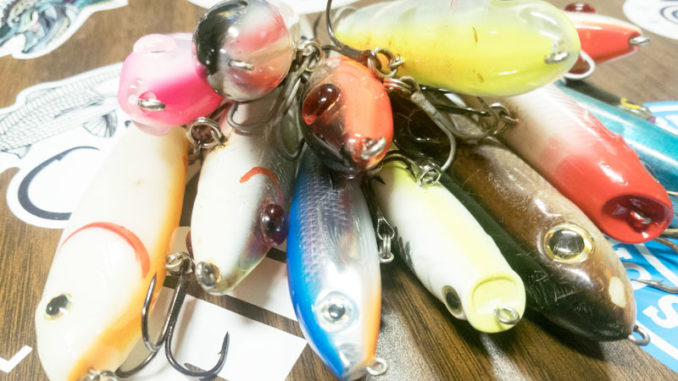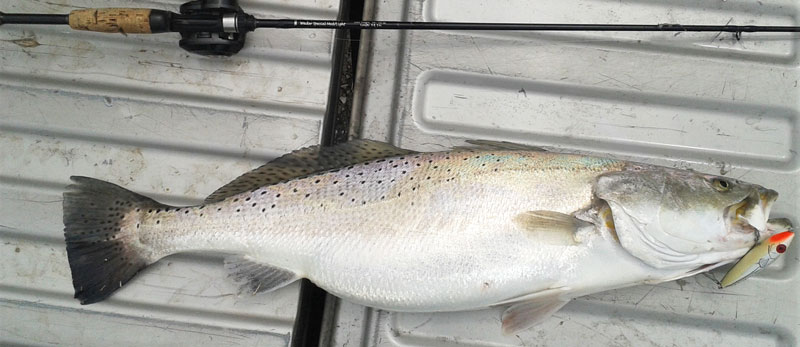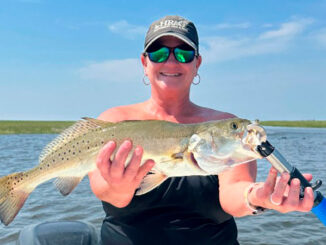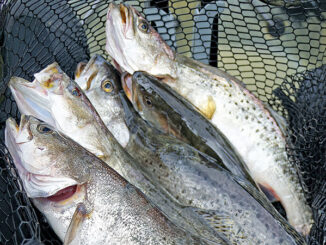
Trout will bust surface baits whenever conditions are right
Before we dive into this month’s discussion about topwater plugs, take a step back in time with me.
In May 2014, I reached the pinnacle of my trout-fishing endeavors. With noble intent to learn more about my “new” homewaters of Corpus Christi, Texas, I was covering an area with a MirrOlure She Dog when an 11-pound giant, 30½ inches long and 17¼ inches in girth, rudely interrupted my quest.
The take was subtle. Over the crest of a wave caused by a strong east wind, I saw a noticeable swirl, and my line went tight. What followed was a remarkable head shake I compare to an underwater coffee can and a fight I’ll never forget.
Earmarked by shot nerves and a quivering voice, I called and messaged those close to me on my accomplishment. Cap-stoning the event was even more impressive. Truth be told, I botched the attempt to release the fish, and since her fate was decided, I chose to clean her after I made the 2½-hour trek back to San Antonio. What I found was mind blowing. As I ran the filet knife down her stomach cavity, a 15-inch trout emerged. A world-class fish had what I considered a “nice trout” in her mid-section, yet was still searching for the dessert to an already healthy meal — fortunately for me it was my topwater!
Limitless potential
Now let’s fast forward and discuss how that relates to the topic at hand. I reflect on that story to show the true capability topwater baits possess. We all know you give up bites when fishing surface plugs. Heck, if I had a dollar for every time I heard an angler say, “I’d rather catch ‘X’ quality trout on topwater versus a limit on a jig or live bait,” a Powerball ticket would seem secondary.
Instead, I’d suggest fishing topwaters and truly understanding how their limitless upside allows you to fish them confidently.
So how do I know when to fish topwater? The answer is, year-round.
Seasonal trends as well as micro-weather events can determine a good surface bite even if the months don’t coincide with fishing literature.
In other words, a warmer-than-normal winter can keep the topwater bite steady, even if it’s January or February. Going a step further, more acute weather anomalies can lead to periods — or days — when topwaters can be effective. In short, steady or spikes in water temperature as a result of rising air temperature can excite big fish in a surface environment.
The other equally important question is, “What plugs should I throw?” Despite limitless options, my encouragement is to keep it simple within the parameters of size, sound, color and profile.
Profile and size
Size and profile go hand-in-hand. A general rule of thumb is to match the lure to the conditions and baitfish in the area.
In clear skies and clear water, I’ll choose smaller-profile lures like Heddon Spook Jr, MirrOlure MirrOmullet or MirrOlure Top Pups. In the event, larger finfish are present or conditions become less than perfect, I’ll upsize to a Heddon One Knocker, MirrOlure Top Dog Jr. or YoZuri 3DR Series Pencil.
Remember, topwater baits mimic baitfish, primarily mullet, so choose the best combination of size and profile to achieve that result.
Sound
Of the four characteristics, I believe sound is the most important. I call it audible presence. Lures like MirrOlure She Dogs or He Dogs have a tremendous audible presence. In clear, calm conditions, the high-pitch presence can be overpowering.
The same can be said when conditions are less than ideal too. Having a bait that “hunts” because of wave action on a pronounced pause can draw just as many ferocious strikes as a consistent walk-the-dog cadence.
Again match the audible presence to the conditions; it can be the difference in success or failure.
Color

In my opinion, I find color the least important of the four. The color spectrum varies widely, but keeping in line with our simple approach, basic colors often get the job done.
In colder months, I find nontraditional or brighter patterns more productive. I attribute this to clarity and density. Clarity fluctuates, but trout-green water in the winter looks totally different than trout-green water in the summer. The only thing I can attribute that to is water density as a result of water temperature.
With less substrate in the water column and generally more overcast skies brought about by weather events, the contrast seemingly works well. Outside of that, I stick to natural colors, as well as chartreuse, pearl, bone, gold, silver and pink.
Additionally, custom color patterns are something to consider if you’re looking to be different from other anglers on the water.
Topwaters have limitless upside year-round when looking for that once-in-a-lifetime trout. As a result, remain encouraged and draw confidence from the past that if there is a trophy in your midst, chances are they’ll eat your bait.
Until next month, tight lines, God bless, and take what you need and release the rest.


